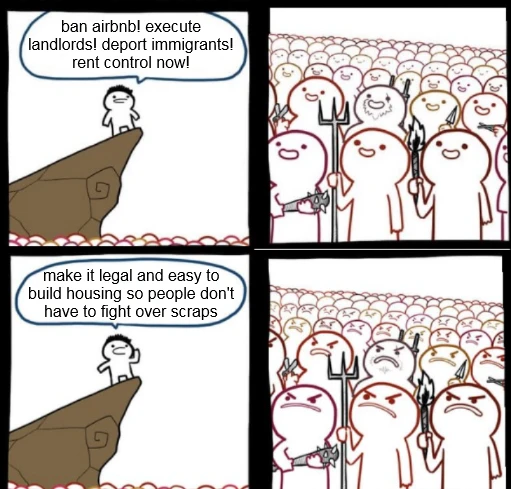this post was submitted on 26 Oct 2024
-1 points (47.6% liked)
Yes in my backyard!
340 readers
4 users here now
In this community, we believe in saying yes to:
- Housing
- Density
- Public transit
- Renewable energy
- Alternatives to cars
Typical YIMBY policies include:
- Elimination of restrictive zoning
- Elimination of parking minimums, setback requirements, and other arbitrary density-decreasing deed restrictions
- Elimination of Euclidean zoning
- Elimination of "inclusionary" zoning
- Elimination of undue red tape that gets in the way of new housing and transit development
- Establishment of stronger "by right" development
- Replacement of property taxes with land value taxes (LVT)
- Construction of high-quality public transit w/ transit-oriented development
- Road diets, with more space dedicated to bikes and pedestrians and less to driving and parking
Typical housing crisis "solutions" YIMBYs are wary of:
- Scapegoating immigrants
- Scapegoating airbnb
- Scapegoating "foreign investors"
- Scapegoating "greedy developers"
YIMBYism transcends the typical left-right political divide; please be respectful of fellow YIMBYs with differing political views. That said, please report anyone saying anything hateful or bigoted.
Reading List
- Housing Breaks People’s Brains
- The Problem With Everything-Bagel Liberalism
- Housing Constraints and Spatial Misallocation
- An Airbnb collapse won’t fix America’s housing shortage
- Cities Start to Question an American Ideal: A House With a Yard on Every Lot
- More Flexible Zoning Helps Contain Rising Rents
- Constraints on City and Neighborhood Growth: The Central Role of Housing Supply
- Progressive Cities Aren't Living Up To Their Values
- Local Effects of Large New Apartment Buildings in Low-Income Areas
- The Origins of Inequality, and Policies to Contain It
- Progress and Poverty
Viewing List
Posting Guidelines
In the absence of a flair system on lemmy yet, let's try to make it easier to scan through posts by type in here by using tags:
- [meta] for discussions/suggestions about this community itself
- [article] for news articles
- [blog] for any blog-style content
- [video] for video resources
- [academic] for academic studies and sources
- [discussion] for text post questions, rants, and/or discussions
- [meme] for memes
- [image] for any non-meme images
- [misc] for anything that doesn't fall cleanly into any of the other categories
Additionally, it is preferred (although not mandatory) to post a brief submission statement in the body of link posts. This is just to give a brief summary and/or description of why you think it's relevant here. Hopefully this will encourage more discussion in this community.
Recommended Communities
founded 2 years ago
MODERATORS
you are viewing a single comment's thread
view the rest of the comments
view the rest of the comments

Doesn't that mean prices stay the same? That doesn't improve affordability.
Market-rate, as a term, just means that it's governed by supply and demand and not externally subsidized. The rest of the text describes how loosening zoning laws spurs housing construction which helps with affordability.
The idea is that, if enough housing gets built, the market rate lowers. For instance, my city Montreal has a lower market rate than, say, San Francisco or Vancouver. Why? Higher supply and lower demand.
Or an even better example: Tokyo. Most populous metro area in the world, but it's also stupidly easy to build apartments and other dense housing by right. The result? The "market rate" for housing in Tokyo is remarkably affordable, even to a minimum wage earner:
https://www.nytimes.com/2023/09/11/opinion/editorials/tokyo-housing.html